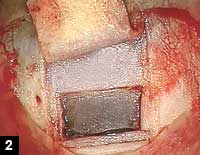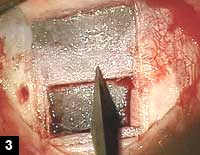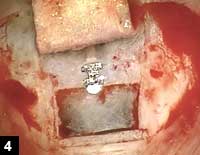Drainage device simplifies glaucoma surgery, reduces risks
New design, procedure for glaucoma drainage device change entry site for implantation.
A change in tube design and the use of deep sclerectomy helped reduce complications with one glaucoma implant, a study found.
Sylvain Roy, MD, MSc, and colleagues presented their findings in a poster at the Association for Research in Vision and Ophthalmology meeting. In a later interview with Ocular Surgery News, Dr. Roy said using the ExPress X-200 drainage device (Optonol) with a “simplified” deep sclerectomy provides a safe, easy and efficient way to control IOP in refractory glaucoma patients.
Originally, the ExPress X-200 was designed for a direct limbus insertion through the iridocorneal angle under a conjunctival flap to drain aqueous from the anterior chamber to the subconjunctival space, Dr. Roy and colleagues said.
However, because of long-term complications, including conjunctival erosions, hypotony, tube dislocation, conjunctival scarring or fibrosis within the tube, the device was redesigned. The new device is inserted under the superficial scleral flap through the trabeculum into the anterior chamber, they said.
The study found that using deep sclerectomy with the ExPress X-200 implant significantly reduced IOP with few complications at 12 months. Of 28 cases, only three were failures.
“This new surgical technique greatly simplifies glaucoma surgery compared to the technically demanding and hard to master deep sclerectomy with collagen implant,” Dr. Roy said. “There is no need to perform the delicate dissection of the trabeculo-Descemet’s window, nor to deal with postoperative Nd:YAG laser goniopuncture.”
The study
Dr. Roy and colleagues conducted the clinical, prospective, nonrandomized, unmasked study on 28 eyes of 28 patients with medically uncontrolled glaucoma or previous failed glaucoma surgeries. Of those cases, 22 had refractory glaucoma. The mean age of the patients was 72 ± 16 years; 10 were men, 18 were women and all patients were Caucasian. Patients were excluded from the study if they had neovascular glaucoma, previous argon laser trabeculectomy or eye surgery within 6 months before the study. Pregnant or nursing women were also excluded.
Deep sclerectomy with the drainage device implantation was performed in all patients, and the mean postop follow-up was 13.87 ± 0.81 months.
At 12-months postop, patients had a mean IOP in the range of 10 mm Hg to 15 mm Hg. Dr. Roy and colleagues found that 20 of 28 patients (71.4%) were a “complete success,” with IOP less than 18 mm Hg without glaucoma medication. Of the 28 patients, 25 (89.3%) were a “qualified success,” with IOP less than 18 mm Hg with or without glaucoma medication.
Of the three surgeries that failed, one patient had traumatic glaucoma, one had congenital glaucoma and one had pseudophakia glaucoma. These patients required further glaucoma surgeries, and by 12-months postop, they were in a “well-stabilized state,” the study reported.
The mean number of medications per patient went from 2.9 ± 0.9 preop to 0.4 ± 0.9 at 12 months postop. Medication was often reintroduced at the second month.
|
|
|
|
|
|
 | The superficial scleral flap is secured using two single nylon 10-0 sutures. Conjunctiva is closed using two running Vicryl 8-0 sutures. Images: Roy S |
Modified design, procedure
The modified design of the drainage device has “refinements” to the tube geometry, according to Dr. Roy. It has a convenient location in the scleral bed, and protection is also provided by the scleral flap against conjunctival erosion, he said.
To perform the procedure, first the scleral space is created by deep sclerectomy. After the ExPress X-200 is inserted under a 5-mm-by-5-mm, 300-µm thick limbus-based superficial scleral flap, aqueous flows through the tube into the intrascleral space, draining out into the subconjunctival and uveoscleral pathway. Schlemm’s canal is not opened in the procedure.
After the insertion of the implant through the paracentesis, Dr. Roy and colleagues ensured that the aqueous was draining correctly into the intrascleral space. Viscoelastic was then inserted into the anterior chamber, and the superficial scleral flap was secured using two single nylon 10-0 sutures. The conjunctiva was closed using two running Vicryl 8-0 sutures.
“This minimally penetrating glaucoma surgery presents the interesting feature of combining the advantage of both approaches: the deep sclerectomy with the different routes created to drain aqueous humor and the direct path from the anterior chamber to the filtering space, akin to the trabeculectomy procedure,” Dr. Roy said. “The advantage over the latter is that the egress of aqueous is precisely controlled by the drainage device and the exact geometry of the inner bore, thus significantly reducing the risk of prolonged postoperative hypotony and all the related complications.”
For more information:
- Sylvain Roy, MD, MSc, can be reached at Glaucoma Unit, Jules Gonin Eyes Hospital, Av de France 15, Ch-1004 Lausanne, Switzerland; 41-21-626-82-24; fax: 41-21-626-82-46. Dr. Roy has no direct financial interest in the products mentioned in this article, nor is he a paid consultant for any companies mentioned.
- Optonol LTD, maker of ExPress X-200 implant, can be reached at Communication Center, Neve Ilan, Israel, 90850; 02-5349666; fax: 02-5349660; e-mail: optonol@optonol.com; Web site: www.optonol.com.
- Erin L. Boyle is an OSN Staff Writer who covers all aspects of ophthalmology.




